|
Battle of Fort Fisher
Fort Fisher Civil War History
Battle of Fort Fisher
Other Names: First Battle of Fort Fisher; Assault on
Fort Fisher; Expedition Against Fort Fisher
Location: New Hanover County
Campaign: Expedition Against Fort Fisher (December 1864)
Date(s): December 7-27, 1864
Principal Commanders: Rear Adm. David D. Porter and Maj. Gen.
Benjamin Butler [US]; Maj. Gen. Robert Hoke [CS]
Forces Engaged: Expeditionary Corps, Army of the James [US];
Hoke’s Division and Fort Fisher Garrison [CS]
Estimated Casualties: 320 total
Result(s): Confederate victory
| Vintage Photo of Fort Fisher Interior Lines |
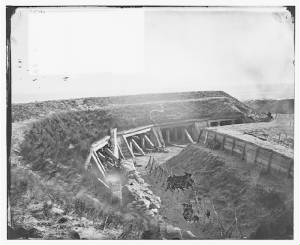
|
| Library of Congress |
Introduction: Maj. Gen. Benjamin Butler was relieved of command
of the Army of the James and assigned to lead an amphibious expedition against Fort Fisher, which protected Wilmington, the
South’s last open seaport on the Atlantic coast. Learning
that large numbers of Union troops had embarked from Hampton Roads on December 13, Lee dispatched Hoke’s Division to
meet the expected attack on Fort Fisher.
On December 24, the Union fleet under Rear Adm. David D. Porter arrived
to begin shelling the fort. An infantry division disembarked from transports to test the fort’s defenses. The Federal
assault on the fort had already begun when Hoke approached, discouraging further Union attempts. Butler called off the expedition
on December 27 and returned to Fort Monroe. (See First Battle of Fort Fisher, aka Expedition Against Fort Fisher,
History: HOMEPAGE.)
Summary: The First Battle of Fort Fisher was a naval siege in the American Civil War, when
Federal forces attempted to capture the fort guarding Wilmington, North Carolina, the South's last major Atlantic port.
Led by Union Maj. Gen. Benjamin Butler, it lasted from December 23–27, 1864.
The Union navy first attempted to detonate a ship filled with powder in order to demolish the fort's walls
but this failed. The navy next launched a two-day bombardment in order to reduce the fort and compel surrender. On the
second day, the Federals began landing troops in order to begin the siege. But Butler got news of enemy reinforcements approaching,
and in the worsening weather conditions, he aborted the operation, declaring the fort to be impregnable. To his embarrassment,
he was relieved two weeks later by Maj. Gen. Alfred H. Terry.
| 1st Battle of Fort Fisher Map |
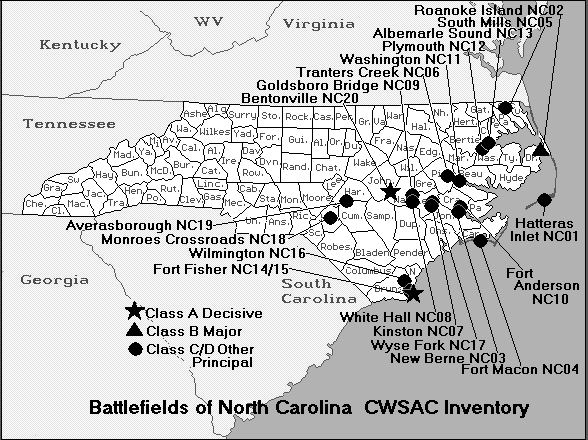
|
| Civil War Fort Fisher Battle Map |
Background: After the failed Bermuda Hundred Campaign,
Major General Benjamin Butler and his Army of the James were assigned to an amphibious expedition against Fort Fisher. Lieutenant
General Ulysses S. Grant had originally designated one of Butler's subordinates, Major General Godfrey Weitzel, to lead the
expedition, but Butler, as the commander of the Department of Virginia and North Carolina, demanded that he lead the troops
himself and Grant acquiesced.
Units for the expedition were selected from the Army of the James and included
the 2nd Division of the XXIV Corps and the 3rd Division from the XXV Corps, along with two battalions of heavy artillery and
engineers. Colonel Cyrus B. Comstock from Grant's staff went along to serve as chief engineer. The Union naval expedition
under Rear Admiral David D. Porter comprised the largest Union fleet of the war, nearly 60 warships along with the transports
to carry the army troops.
Butler also planned to bring the USS Louisiana, which had been packed with
200 tons of powder and disguised as a blockade runner, down to Fort Fisher, run it aground about a hundred yards from the
fort's seawall, and blow it up, hoping the explosion would demolish the fort as well. Although many in the Union high command
(including Grant and Gideon Wells) doubted the plan would work, but it was approved by Lincoln. The final Union plan was for
the ships to gather at Hampton Roads, where the army troops would board the transports. Because the monitors used in the attack
had to be towed to Fort Fisher, the navy would leave with a twelve hours head start over the transports. The warships would
refuel at Beaufort, then meet the transports at Fort Fisher, when the Louisiana would be detonated and the troops landed under
the fire of the warships.
Fort Fisher, on Confederate Point, nicknamed the "Gibraltar of the Confederacy",
was a formidable target commanding the Cape Fear River. It encompassed 14,500 ft. and was surrounded by a 10-foot parapet
and a network of bombproofs, most of which were 30 feet high. Many obstructions were laid around it, including land mines
(called torpedoes in this era), abatis, and deep ditches. There were more than 50 heavy cannon, including 15 Columbiads and
a 150-pounder Armstrong gun, behind a 60-foot mound of earth near the sea, named the Mound Battery. The fort's garrison of
1,400 men was commanded by Colonel William Lamb. Additional reinforcements were available from General Braxton Bragg at Sugar
Loaf, 4 miles away. This force consisted of Major General Robert F. Hoke's division from the Army of Northern Virginia, which
arrived on December 13.
| Civil War Fort Fisher History |
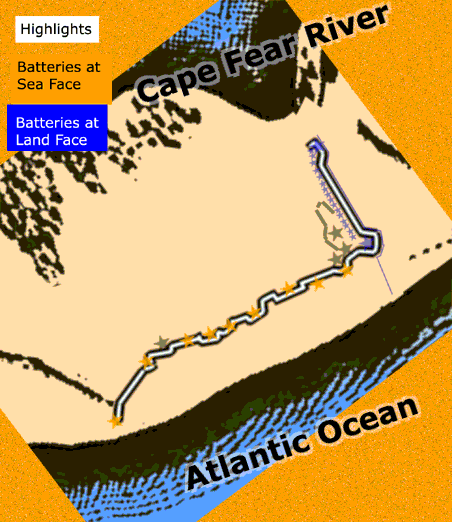
|
| Formidable Fort Fisher Defenses |
| Civil War Fort Fisher |
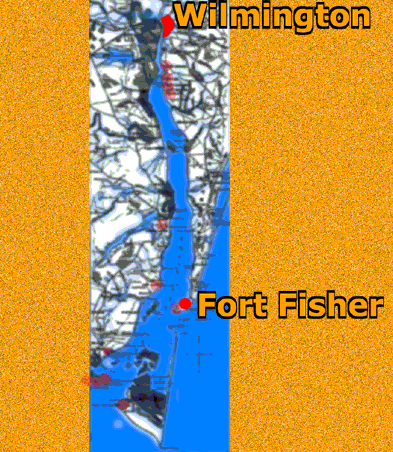
|
| Fort Fisher Defenses |
Battle: The Union forces prepared to leave Hampton Roads
on December 10, but a winter storm hit the fleet for three days, preventing the fleet's departure until the 14th. The transports
carrying Butler's force arrived at Fort Fisher first, since the navy took longer to refuel at Beaufort than expected. When
Porter's ships arrived on the 19th, another storm hit the fleet, causing some ships to scatter and forcing the army transports
to return to Beaufort. After the storm subsided on the 23rd, Porter decided to start the attack without Butler, ordering the
Louisiana to be blown up that night. Near midnight, the ship was towed close to the fort's seawall and set on fire. However,
the Louisiana was farther out to sea than the navy thought, perhaps as far as a mile offshore; as a result, Fort Fisher was
undamaged by the blast.
The following morning (December 23), the Union navy moved closer to shore
and began a bombardment of the fort, hoping to damage the earthworks and forcing the garrison to surrender. Despite firing
close to 10,000 shells that day, only minor damage was caused, with four seacoast gun carriages disabled, one light artillery
caisson destroyed, and 23 casualties in the garrison. Meanwhile there were 45 Union casualties from exploding guns aboard
ships, and the Confederates were able to score direct hits on three ships.
The transports carrying the Union soldiers arrived that evening. Initially,
Butler thought that by exploding the Louisiana and starting the bombardment without the army, Porter had given the Confederates
warning that the Union assault was coming and would therefore have time to contest the landings. However he was convinced
to land a reconnaissance party to determine if an attack was still feasible. The landings started Christmas morning, with
Brig. Gen. Adelbert Ames' division the first to be ashore, while the navy continued bombarding the fort. The Union troops
captured a battery protecting the beach north of Fort Fisher, and accepted the surrender of the 4th and 8th North Carolina
Junior Reserve battalions, which had been cut off by the Union landings. After setting up a defensive line, Ames sent the
brigade of N. Martin Curtis towards the fort to see if it could be attacked. Curtis found the land wall lightly defended and
was prepared to attack, but was prevented from doing so by Ames. Butler was convinced that the fort was undamaged and too
strong for an assault; he had also received word that Hoke's division was a few miles north of the fort, and another storm
was forming in the area. All this convinced him to halt the landings and order the troops on the beach to return to the ships;
the entire Union fleet then returned to Hampton Roads.
Aftermath: The fiasco at Fort Fisher, specifically
Butler's disobeyance of his direct orders—orders which Butler failed to communicate either to Porter or to Weitzel—gave
Grant an excuse to relieve Butler, replacing him in command of the Army of the James by Major General Edward Ord. President
Abraham Lincoln, recently reelected, no longer needed to keep the prominent Republican in the Army and he was relieved on
January 8, 1865. To Butler's further embarrassment, Fort Fisher fell one week later when Major General Alfred H. Terry led
a second assault against the Confederate stronghold; while defending his decision to break off the attack before the Joint
Committee on the Conduct of the War, Butler had deemed the fort impregnable.
Confederate losses amounted to five killed and mortally wounded, fifty-six
wounded, and six hundred captured, while the damage caused by the bombardment was quickly repaired. Blockade runners continued
using the port, the next ships to arrive did so the very night the Union fleet withdrew. Although Whiting and Lamb were convinced
that the Union force would shortly return, Bragg withdrew Hoke's Division back to Wilmington and started making plans to recapture
New Bern.
| Fort Fisher Battlefield |
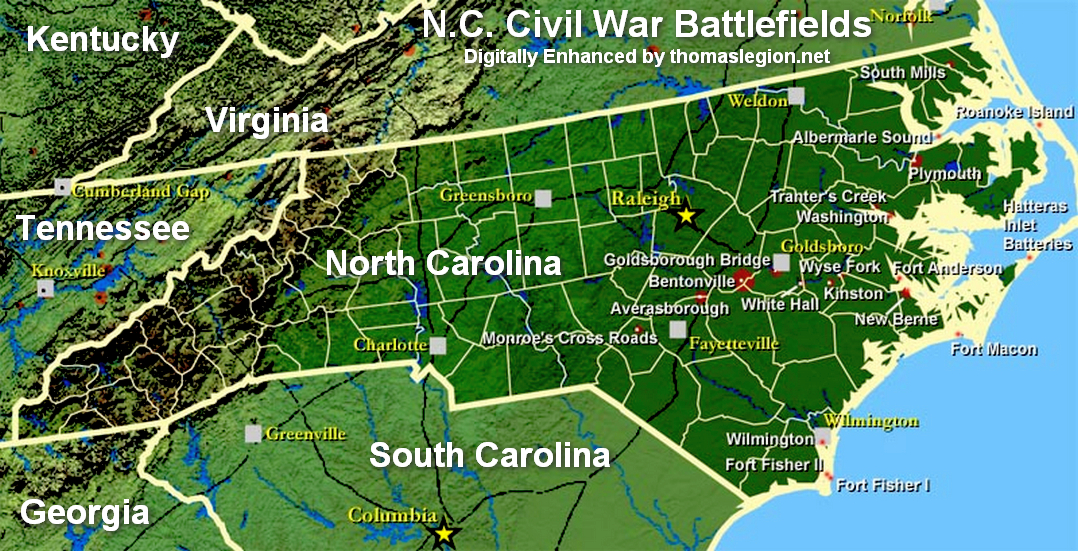
|
| Battle of Fort Fisher |
| Fort Fisher Civil War History |

|
| The sea face of Fort Fisher in 1865 |
Analysis: On December 15, 1864, Jefferson Davis supposed
that Wilmington had not yet been attacked because it would have demanded "the withdrawal of too large a [Union] force from
operations against points which they deem more important to us." Otherwise, "fleets and armies" would have already been "at
the mouth of the Cape Fear."
In December 1864, Union Major General Benjamin Butler, together with the
Expeditionary Corps of the Army of the James, was detached from the Virginia theater for an amphibious mission to capture
Fort Fisher. He was joined by Rear Admiral David Dixon Porter who commanded Union naval forces already in the
region. After being informed about the large Union army heading toward
Wilmington, General Lee ordered Major General Robert Hoke 's Division to Fort Fisher. Also, Hoke took command of all Confederate
forces in the Wilmington area.
The Union attack commenced on December 24, 1864, with a naval bombardment.
The firepower of Fort Fisher was temporarily silenced because some of its gun positions exploded. This allowed the Navy to
land Union infantry . The landing force was intercepted by the arrival of Hoke's troops. The Union attack was effectively
thwarted, and on December 27th Benjamin Butler ordered the withdrawal of his 1,000 soldiers who were still on the beach. This
was in disobeyance of Grant's orders, which were to besiege the fort if the assault failed. Because Butler disobeyed his orders,
he was relieved of command by Grant.
(Sources and related reading listed below.)
Recommended
Reading: Confederate Goliath: The Battle of Fort
Fisher. From Publishers Weekly: Late in the Civil War, Wilmington, N.C., was the sole remaining seaport supplying Lee's army at Petersburg,
Va., with rations and munitions. In this dramatic account, Gragg describes the
two-phase campaign by which Union forces captured the fort that guarded Wilmington and the subsequent occupation of the city
itself--a victory that virtually doomed the Confederacy. In the initial phase in December 1864, General Ben Butler and Admiral
David Porter directed an unsuccessful amphibious assault against Fort
Fisher that included the war's heaviest artillery bombardment. Continued
below…
The second
try in January '65 brought General Alfred Terry's 9000-man army against 1500 ill-equipped defenders, climaxing in a bloody
hand-to-hand struggle inside the bastion and an overwhelming Union victory. Although historians tend to downplay the event,
it was nevertheless as strategically decisive as the earlier fall of either Vicksburg or Atlanta. Gragg
has done a fine job in restoring this important campaign to public attention. Includes numerous photos.
Advance to:
Recommended
Reading: Hurricane of Fire: The Union Assault on Fort Fisher
(Hardcover). Review: In December 1864 and January 1865, Federal forces launched the greatest amphibious assault the world
had yet seen on the Confederate stronghold of Fort Fisher,
near Wilmington, North Carolina.
This was the last seaport available to the South--all of the others had been effectively shut down by the Union's
tight naval blockade. The initial attack was a disaster; Fort
Fisher, built mainly out of beach sand, appeared almost impregnable against
a heavy naval bombardment. When troops finally landed, they were quickly repelled. Continued below…
A second attempt
succeeded and arguably helped deliver one of the death blows to a quickly fading Confederacy. Hurricane of Fire is a work
of original scholarship, ably complementing Rod Gragg's Confederate Goliath, and the first book to take a full account of
the navy's important supporting role in the assault.
Recommended
Reading: Rebel Gibraltar: Fort Fisher and Wilmington, C.S.A. Description: Even before the rest of North Carolina joined her sister states in secession,
the people of the Lower Cape Fear were filled with enthusiasm for the Southern Cause - so much so that they actually seized
Forts Johnston and Caswell, at the mouth of the Cape Fear River, weeks before the first shots were fired at Fort Sumter. When
the state finally did secede, Wilmington became the most important port city of the Confederacy, keeping Robert E. Lee
supplied with the munitions and supplies he needed to fight the war against the North. Continued below…
Dedicated soldiers
like William Lamb and W.H.C. Whiting turned the sandy beaches of southern New Hanover and Brunswick Counties into a series
of fortresses that kept the Union
navy at bay for four years. The mighty Fort Fisher
and a series of smaller forts offered safe haven for daring blockade runners that brought in the Confederacy's much-needed
supplies. In the process, they turned the quiet port of Wilmington into a boomtown. In this book that was fifteen years in the making, James
L. Walker, Jr. has chronicled the story of the Lower Cape Fear and the forts and men that guarded it during America's bloodiest conflict, from the early days of the war to the fall of Wilmington in February 1865.
Recommended Reading: The Civil War in the Carolinas (Hardcover). Description: Dan Morrill relates the experience of two quite different states bound together in
the defense of the Confederacy, using letters, diaries, memoirs, and reports. He shows
how the innovative operations of the Union army and navy along the coast and in the bays and rivers of the Carolinas
affected the general course of the war as well as the daily lives of all Carolinians. He demonstrates the "total war" for
North Carolina's vital coastal railroads and ports. In
the latter part of the war, he describes how Sherman's operation
cut out the heart of the last stronghold of the South. Continued below...
The author
offers fascinating sketches of major and minor personalities, including the new president and state governors, Generals Lee,
Beauregard, Pickett, Sherman, D.H. Hill, and Joseph E. Johnston. Rebels and abolitionists, pacifists and unionists, slaves
and freed men and women, all influential, all placed in their context with clear-eyed precision. If he were wielding a needle
instead of a pen, his tapestry would offer us a complete picture of a people at war. Midwest Book Review: The Civil War in the Carolinas by civil war expert and historian
Dan Morrill (History Department, University of North Carolina at Charlotte, and Director of the Charlotte-Mecklenburg Historical
Society) is a dramatically presented and extensively researched survey and analysis of the impact the American Civil War had
upon the states of North Carolina and South Carolina, and the people who called these states their home. A meticulous, scholarly,
and thoroughly engaging examination of the details of history and the sweeping change that the war wrought for everyone, The
Civil War In The Carolinas is a welcome and informative addition to American Civil War Studies reference collections.
Recommended
Reading: The Wilmington Campaign and the Battle for Fort Fisher, by Mark A. Moore. Description:
Full campaign and battle history of the largest combined operation in U.S.
military history prior to World War II. By late 1864, Wilmington
was the last major Confederate blockade-running seaport open to the outside world. The final battle for the port city's protector--Fort Fisher--culminated
in the largest naval bombardment of the American Civil War, and one of the worst hand-to-hand engagements in four years of
bloody fighting. Continued below…
Copious illustrations,
including 54 original maps drawn by the author. Fresh new analysis on the fall of Fort Fisher, with a fascinating comparison
to Russian defenses at Sebastopol during the Crimean War. “A tour de force. Moore's Fort Fisher-Wilmington Campaign is the best publication of this
character that I have seen in more than 50 years.” -- Edwin C. Bearss, Chief Historian Emeritus, National Park Service
Recommended
Reading: The Wilmington
Campaign: Last Departing Rays of Hope. Description: While prior books on the battle to capture Wilmington,
North Carolina, have focused solely on the epic struggles for Fort Fisher, in many respects this was just
the beginning of the campaign. In addition to complete coverage (with significant new information) of both battles for Fort Fisher, "The Wilmington Campaign" includes the first
detailed examination of the attack and defense of Fort Anderson. It also features blow-by-blow accounts of the defense of the Sugar Loaf Line
and of the operations of Federal warships on the Cape Fear River. This masterpiece of military
history proves yet again that there is still much to be learned about the American Civil War. Continued below…
"The Wilmington
Campaign is a splendid achievement. This gripping chronicle of the five-weeks' campaign up the Cape Fear River adds a crucial dimension
to our understanding of the Confederacy's collapse." -James McPherson, Pulitzer Prize-winning author of Battle Cry of Freedom
Recommended
Reading: Seacoast Fortifications of the United States:
An Introductory History. Reader’s
Review: In the thirty years since this book was published, one always hoped another would equal or surpass it. None has, or
perhaps ever will. It is a marvelous history of the Forts along the American Seacoast, both Atlantic and Pacific, and even
the Philippines. …Any Fort enthusiast
must read this book. The author captures so much information, so many views, so much perspective in so few pages, the book
is breathtaking. It is easily the finest book on its chosen subject, which is why it never goes out of print. “If forts
interest you, read it, period.” The photographs from the author's collection, the army's files, the National Archives,
etc., make it an invaluable edition. Continued below…
But the text,
the clear delineation of the periods of fort building since 1794 in the US, and the differentiation of the periods,
are so worth while. Ray manages to be both terse, and pithy. It is a great tribute to any author to say that. “This
is a MUST read for anyone interested in the subject, even one only interested in their own local Fort, and how it relates
to the defense plans of the United States when it was built.” “[T]here is NO better book to read on the subject.”
Sources: National Archives; Library of Congress; Fonvielle, Chris E., Jr.
Last Rays of Departing Hope: The Wilmington Campaign. Campbell, CA: Savas Publishing Company, 1997. ISBN 1-882810-09-0; Gragg,
Rod. Confederate Goliath: The Battle of Fort Fisher. New York: HarperCollins, 1991. ISBN 978-0-06-016096-8; The Photographic
History of The Civil War in Ten Volumes: Volume Five, Forts and Artillery. The Review of Reviews Co., New York. 1911. p. 265.
|

